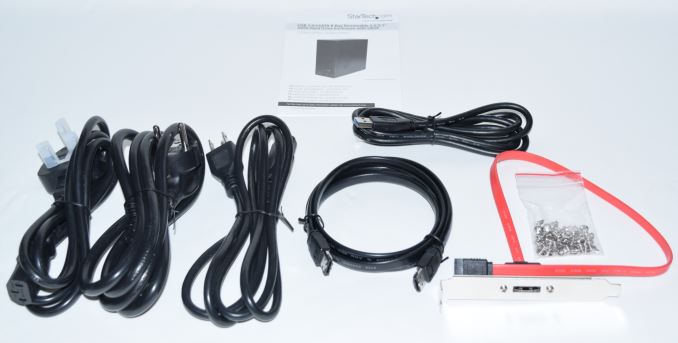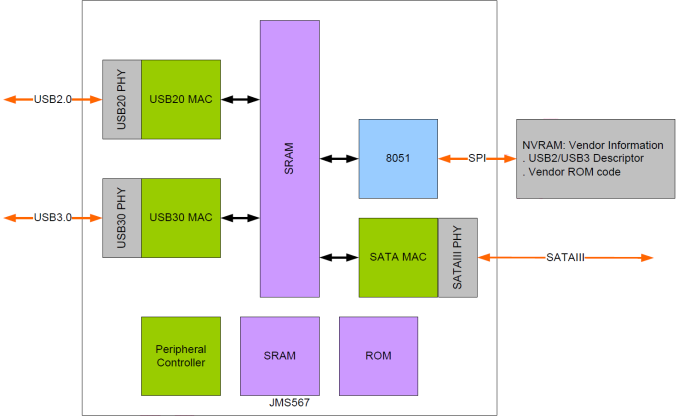StarTech.com 8-bay USB 3.0 / eSATA Removable Hard Drive Enclosure Review
by Ganesh T S on August 11, 2015 8:00 AM EST- Posted in
- Storage
- USB 3.0
- eSATA
- DAS
- StarTech.com

Introduction and Usage Impressions
Direct Attached Storage (DAS) units have been the go-to devices for consumers looking to store large amounts of data, though they are being slowly replaced by Network Attached Storage (NAS) units in certain scenarios. The advent of high-speed interfaces such as USB 3.x and Thunderbolt have enabled a new generation of DAS units that enable the host system to access the member disks without any bottlenecks. The last time we looked at a multi-bay external enclosure was in our review of the Mediasonic Probox. A couple of years have passed since we checked out the JMicron JMB321 port-multiplier coupled with a JSM 539 SATA to USB 3.0 bridge. These JMicron parts have been discontinued and new parts have been introduced for economical multi-bay direct-attached storage enclosures.
StarTech.com specializes in gadgets performing niche, yet handy functions. We have reviewed a few of their products such as the USB 3.0 to SATA IDE HDD docking station and portable SATA duplicator before. Technology-wise, there are plenty of similar options in the market. StarTech.com hopes to differentiate itself by acting as a one-stop shop for all these miscellaneous needs. Since the beginning of the year, StarTech.com has launched two interesting products in the DAS (direct-attached storage) space. On the high-end side, we have the S354SMTB2R, a 4-bay Thunderbolt 2 enclosure with a price point just south of $700. Two USB 3.0 / eSATA enclosures have also been introduced around the $300 and $400 price points. The $315 S355BU33ERM 5-bay enclosure and the $392 S358BU33ERM 8-bay enclosure support both 3.5" and 2.5" drives. Hot-swapping is also supported.
Similar to the Mediasonic Probox, they come with both eSATA and USB 3.0 host connections. UASP is now supported, thanks to the usage of the JMicron JMB575M SATA port multiplier / selector and JMS567 SATA to USB 3.0 bridge controller. The 5-bay unit comes with a 80 mm cooling fan, while the 8-bay unit has a 120 mm cooling fan. These are JBOD enclosures (no hardware RAID).
The S358BU33ERM comes in a large white box with the UASP support prominently highlighted. In addition to the main unit (pictured at the top), the package also contains the following:
- Three different power cords (NA, EU and UK)
- eSATA cable
- USB 3.0 Type-A Male to Type-B Male cable
- Instruction manual
- SATA to eSATA full-profile bracket (for PCs without an eSATA port, but a spare SATA port on the motherboard)
- 32x screws for 2.5" drives and 32x screws for 3.5" drives
In addition, the main unit has the drive trays pre-installed. The gallery below takes us around the unit.
The placement of the two ports is ideal (unlike the recessed ones in the Mediasonic Probox). The drive trays are also much better than the Probox. The aspect I liked most about the chassis was that the drive trays could easily slot in, thanks to the guiding notches on either side. However, unlike the Probox, the StarTech.com unit has only one fan. The 300W power supply is built into the unit.
Coming back to the core platform, we have the JMB575M SATA port multiplier. Its block diagram is provided below. Note that two of these port multipliers are used in the DAS in a cascaded manner (each part can be configured in a 5-to-1 connection at the maximum).
The SATA III to USB 3.0 bridge chip (JMS567) also taps into the SATA connection just prior to the eSATA interface in the board.
In the rest of the review, we will first cover the testbed setup and evaluation methodology, followed by a look at the benchmarks in eSATA as well as USB 3.0 mode.



















21 Comments
View All Comments
jardows2 - Tuesday, August 11, 2015 - link
Interesting product. As I was reading though, I kept thinking "How would I be able to use something like this?" I couldn't find in my mind any real scenario where this would be better than a NAS, until the last page where it was mentioned you could use this to help rebuild a RAID array. I'd love to see a more in-depth article/HOWTO on this process!dave_the_nerd - Thursday, August 13, 2015 - link
In general, this would be quite a bit faster than a NAS. So if you have any kind of data that's big but only needs to be accessed by a single computer (say, you're doing video production) these sorts of DAS enclosures are a pretty common sight.They're also useful for expanding a homebuilt NAS or file server.
Visual - Friday, August 21, 2015 - link
Um. Plug this in the USB port of most any home router made in the past decade, and you have a NAS.dhotay - Tuesday, August 11, 2015 - link
I don't see the value of testing this case with all SSDs instead of spinners. The thermal and power usage benchmarks are best-case scenarios, thanks to that decision.basroil - Tuesday, August 11, 2015 - link
Recently ran out of SATA ports on my tower and was seriously considering adding one of these devices to my collection. ~200MB/s write and ~100MB/s read is perfect for my photo/raw footage collection mid tier storage. Mind doing a few more of these on 5-10 drive switched enclosures? The cost savings compared to something like a drobo when all you want is direct attached storage is huge.Navvie - Tuesday, August 11, 2015 - link
I have a similar 4 bay JBOD e-SATA enclosure connected to my Gen8 microserver NAS. Adds more drive capacity without having to buy a new machine.I'd struggle to come up with any other use for them. Certainly my next NAS build will have more internal bays.
joex4444 - Tuesday, August 11, 2015 - link
DAS devices have a couple other uses. They are similar to external drives, though they might logically be a RAID device, so they let you choose which volumes are on based on your current needs. This is good because it saves power and reduces noise. Further, if you can use DAS devices to have a single SSD in your build and all your hard drives in the DAS then you reduce the amount of heat in your PC. I'd much rather have 8 drives in a separate box with a separate PSU and fan than try to get my tower to also stay cool with 8 HDDs stuffed in it, which also impede airflow as they dump extra heat into the system.karpodiem - Tuesday, August 11, 2015 - link
Is it possible to do software RAID6 in Linux if all eight drives were empty?digitalgriffin - Tuesday, August 11, 2015 - link
With ZFS you could. However this eSATA enclosure chip only has hardware JBODfackamato - Tuesday, August 11, 2015 - link
So software RAID6 in Linux would work great then?